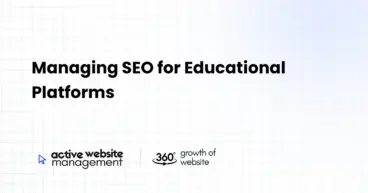December 19, 2024
7 min read
Website maintenance is not just about fixing broken links or updating content every now and then. It’s a continual process that ensures a website performs optimally, remains secure, and offers a good user experience. In today’s fast-evolving digital landscape, website maintenance is crucial for businesses, organizations, and individuals who rely on their online presence to connect with customers, generate leads, and stay competitive.
This guide covers everything you need to know about effective website maintenance, including best practices, strategies, and tools for 2025. We’ll also touch on Active Website Management and how it can benefit your site in the long run.
1. What is Website Maintenance?
Website maintenance is the process of regularly updating and checking a website to ensure that it runs smoothly. This includes tasks like software updates, bug fixes, content updates, security patches, and performance optimization. Unlike web design or development, maintenance is an ongoing process that ensures a site continues to function well after its launch.
2. Why is Website Maintenance Important?
Website maintenance is crucial for several reasons:
- User Experience: Websites that are slow, outdated, or prone to errors can frustrate users and drive them away. Regular maintenance ensures that your website is user-friendly and performs optimally.
- Search Engine Rankings: Google and other search engines prioritize websites that load quickly, offer fresh content, and are secure. Poorly maintained websites may suffer from low rankings, reducing visibility.
- Security: Hackers often target outdated websites with unpatched security vulnerabilities. Regular updates and security checks protect your website from malware and cyber-attacks.
- Business Growth: A well-maintained website improves brand reputation, drives traffic, and enhances customer trust, ultimately contributing to business success.
3. Key Elements of Website Maintenance
Website maintenance can be broken down into several key areas:
Don’t Just Maintain Your Website—
Grow It using Active Website Management! Don't Wait for Growth—Accelerate It with Active Website Management
A. Content Updates
- Why It Matters: Fresh content is vital for both user engagement and SEO. Keeping your blog, product listings, and other content up-to-date ensures that visitors return for new information.
- How to Do It: Regularly update your blog posts, add new articles, update product descriptions, and ensure all content is relevant to current trends. If you want more tips on content strategy, check out our post on Content Strategy for Search Engine Traffic.
B. Security Maintenance
- Why It Matters: Cybersecurity is one of the most important aspects of website maintenance. Outdated software can make your site vulnerable to hacks.
- How to Do It: Apply software patches and security updates promptly. Use secure protocols (SSL/TLS), and regularly audit your website for security vulnerabilities. For more details, visit our Website Security in 2025 guide.
- Why It Matters: Website speed directly impacts user experience and SEO rankings. Slow loading times lead to higher bounce rates.
- How to Do It: Use tools like Google PageSpeed Insights, and optimize images, minify CSS/JS, and leverage browser caching. Our Website Performance Optimization article provides an in-depth approach to optimizing your website’s speed.
D. Backup Management
- Why It Matters: Backups ensure you won’t lose valuable data in case of unexpected issues like server crashes, hacks, or accidental deletions.
- How to Do It: Regularly back up your website’s files and databases. Store backups off-site or in the cloud to ensure data security. You can find a useful Website Maintenance Checklist for 2024 for setting up regular backups.
4. Active Website Management: The Future of Website Care
Active website management is a proactive approach to website maintenance that includes continuous monitoring and optimization. Unlike traditional maintenance, which reacts to problems, active website management anticipates and prevents issues before they arise.
Key Benefits of Active Website Management:
- Real-time Monitoring: Ensures that your website is always up and running.
- Improved Security: Regular security checks help in identifying potential threats early.
- Better User Experience: Continuous optimization ensures faster load times and better mobile responsiveness.
5. Essential Website Maintenance Tasks
To keep your website in top shape, you need to perform certain essential tasks regularly:
A. Regular Software Updates
- What to Update: Content management systems (CMS) like WordPress, plugins, and themes.
- Why It’s Important: Updates fix bugs, patch security holes, and improve website functionality.
B. Monitoring Website Analytics
- What to Monitor: Page views, bounce rates, traffic sources, and conversion rates.
- Why It’s Important: Analytics provide insights into how users are interacting with your site, helping you make informed decisions for optimization.
Don't Wait for Growth—Accelerate It with
Active Website Management Don't Wait for Growth—Accelerate It with Active Website Management
C. Broken Link Checking
- Why It’s Important: Broken links negatively impact user experience and SEO. Use tools like Screaming Frog to identify and fix broken links regularly.
D. Mobile Responsiveness Checks
- What to Check: Ensure that your website looks and functions well on various mobile devices.
- Why It’s Important: Mobile-friendliness is a ranking factor for Google, and a site that isn’t mobile-responsive risks losing traffic.
6. Best Practices for Website Maintenance
To help your website thrive, here are some best practices for website maintenance:
- Develop a Maintenance Schedule: Set a schedule for regular maintenance tasks such as content updates, security checks, and performance optimizations. Our Website Maintenance Schedule provides a helpful framework for planning.
- Test Before You Update: Before updating plugins, themes, or core systems, always test in a staging environment to avoid breaking live functionality.
- Automate Where Possible: Automate backups, updates, and security scans using plugins and tools. This saves time and reduces human error.
7. Common Website Maintenance Mistakes to Avoid
Website maintenance can be overwhelming, and it’s easy to make mistakes. Here are some common ones:
- Neglecting Regular Backups: Failure to back up regularly can result in data loss if something goes wrong.
- Ignoring Mobile Optimization: As mobile traffic continues to grow, failing to optimize for mobile devices can lead to a poor user experience.
- Postponing Software Updates: Delaying updates leaves your site vulnerable to security threats.
For more tips on how to avoid mistakes, read our article on Website Management Mistakes.
8. Tools for Website Maintenance
To streamline website maintenance, consider using the following tools:
- Google Search Console: Helps monitor and fix issues related to your site’s visibility in search results.
- Screaming Frog: A tool for crawling websites and finding broken links, duplicate content, and more.
- WP Rocket: A caching plugin that speeds up WordPress websites.
- UpdraftPlus: A backup plugin for WordPress that automatically saves backups of your site’s data.
For more on tools and strategies, explore our Tools for Website Monitoring post.
9. How Often Should You Perform Website Maintenance?
The frequency of website maintenance depends on various factors such as your website’s size, complexity, and traffic. However, here’s a general guideline:
- Weekly: Check analytics, review website performance, and perform security scans.
- Monthly: Update content, test the website on various devices, and check for broken links.
- Quarterly: Perform full backups, update plugins/themes, and conduct a website audit.
10. Website Maintenance Checklist for 2024
Here’s a comprehensive checklist to help you stay on track with your website maintenance:
- Content Updates: Review and refresh content monthly.
- Security Updates: Apply patches and monitor security at least once a week.
- Performance Optimization: Check page load speeds and optimize images quarterly.
- Backup Management: Schedule automated backups monthly.
- Mobile Responsiveness: Test on various devices at least quarterly.
11. Conclusion: Maintaining a Healthy Website for the Future
Website maintenance is an ongoing, crucial task for ensuring that your site remains functional, secure, and competitive. By following the best practices and strategies outlined in this guide, you can avoid common pitfalls and improve your site’s performance, security, and user experience. Whether you’re a small business owner or managing a large enterprise, investing time in regular website maintenance will pay off in the long run.
For further guidance and resources, check out our blog at Active Website Management.






